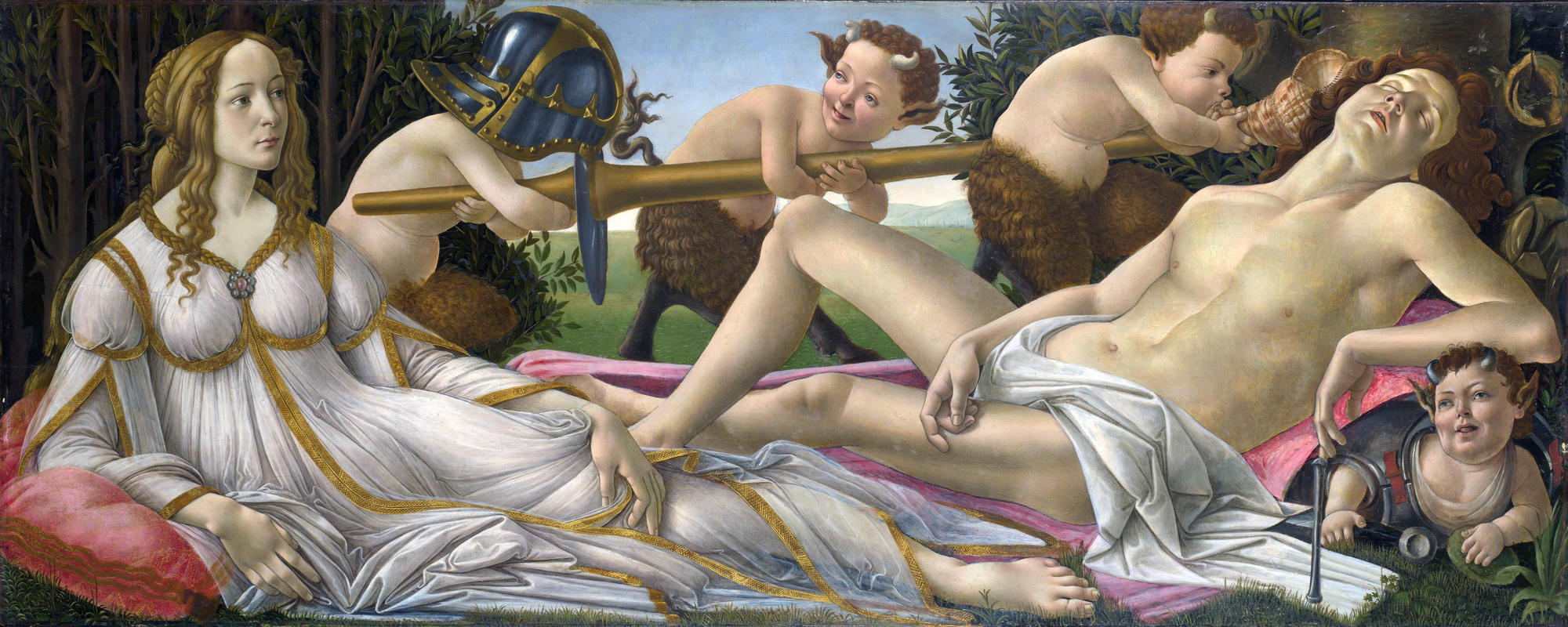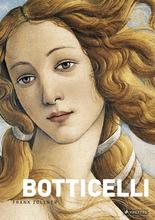More about Venus and Mars
- All
- Info
- Shop

Contributor
In Sandro Botticelli’s Venus and Mars, the artist depicts a scene from Greco-Roman mythology portraying the god of war, Mars, and the goddess of love, Venus, in a rather compromising position.
After engaging in some passionate lovemaking, Mars lays across from Venus, asleep, snoring, mostly naked, and exhausted from all the sex-having. Venus, on the other hand, remains calm and collected, fully clothed, the picture of perfection. The goddess’s hair seems to be woven into the fabric of her dress, an irony on the part of the artist because you know that thing had to come off at some point if you catch my drift. By representing the gods as such, Botticelli gives power to the female body, as she has “conquered” Mars. In this way, the painting becomes an allegory for the notion that love conquers war.
Commissioned by the Vespucci family in late 15th century Florence, Venus and Mars originally served as a wedding gift for a bride. These types of paintings typically hung in a multi-purpose room called the camera. People would bring their guests into the camera to flaunt their prized possessions, including art pieces such as this one, family portraits, and treasures of the sort. Also, when a man and his wife attempted to conceive a child, they did so in the camera. They believed that when a woman looks at a beautiful man or babies before sex it increased her likelihood of conceiving a male child, hence the immaculate male form of Mars surrounded by little putti, baby cupids.
In this painting, Botticelli represents putti as satyrs, which in Greco-Roman mythology are drunk and perpetually aroused half-man, half-goat creatures that partied all the time. The word satyric, meaning a lewd and lustful person, originates from this mythological creature. In classical art, satyrs are typically represented with human bodies, goat legs, a tail, ears, and a massive, raging erection. The technical term for these half-man, half-goat boners is ithyphallic. No, this vocab word is not relevant to your understanding of this painting, but I’m fascinated by the fact that there is a real, technical term for satyr boners and I felt compelled to share this information. Botticelli’s clever depiction of putti as satyrs combines the representation of love (cupids), with sex and fertility (satyrs). Though the artist depicts the satyrs in Venus and Mars as babies rather than fully-grown men with exaggerated erect penises, the historical and mythological context of these creatures directly relates to the purpose of this commission as a wedding gift to a newlywed couple.
Each time I look at this painting, I see something new. Like the wasps near Mars’s ear, ready to sting at any second. Some art historians believe this to be a reference to the sting of love, while others insist that it references the Vespucci family because the word for wasp in Italian is vespe. Another fun detail is the satyr peeking out at the audience through Mars’s armor, ready to awaken Mars from his deep sleep. With so much rich imagery, Botticelli captures a playfulness and humor that would have been appreciated by its viewers in the work's original context, and is still enjoyed and celebrated today.
Sources
- Wilson, Bronwen. "The Body and Domestic Space." Art History 121B: 15th Century Italian Art. Class Lecture, UCLA, Los Angeles, CA, 2017.
- Campbell, Caroline. “Sandro Botticelli: Venus and Mars in Renaissance Florence.” Lunchtime Talks. National Gallery, London, UK, 2017.
- “Sandro Botticelli Artworks & Famous Paintings.” The Art Story. The Art Story Foundation, n.d. https://www.theartstory.org/artist/botticelli-sandro/artworks.
- Brouwers, Josho. “Satyrs, Sileni, and Fauns - Lustful Graeco-Roman Spirits of Nature.” Ancient World Magazine, March 26, 2018. https://www.ancientworldmagazine.com/articles/satyrs-sileni-fauns-lustf….
Featured Content
Here is what Wikipedia says about Venus and Mars (Botticelli)

Venus and Mars (or Mars and Venus) is a panel painting of about 1485 by the Italian Renaissance painter Sandro Botticelli. It shows the Roman gods Venus, goddess of love, and Mars, god of war, in an allegory of beauty and valour. The youthful and voluptuous couple recline in a forest setting, surrounded by playful baby satyrs.
The painting was probably intended to commemorate a wedding, set into panelling or a piece of furniture to adorn the bedroom of the bride and groom, possibly as part of a set of works. This is suggested by the wide format and the close view of the figures. It is widely seen as representation of an ideal view of sensuous love. It seems likely that Botticelli worked out the concept for the painting, with its learned allusions, with an advisor such as Poliziano, the Medici house poet and Renaissance Humanist scholar.
The exact date of Venus and Mars is not known, but the National Gallery's dated the painting to "c. 1485" in 2017. Scholar Ronald Lightbown dates it to "probably around 1483", while art historians Leopold and Helen Ettlinger date the painting to "the latter half of the 1480s". All dates depend on analysis of the style, as the painting has not been convincingly tied to a specific date or event, such as a wedding. It likely comes a few years after the Primavera and Pallas and the Centaur (both about 1482) and around the time of The Birth of Venus (c. 1486). It is the only one of these paintings not in the Uffizi in Florence; it has been in the National Gallery in London since 1874.
Check out the full Wikipedia article about Venus and Mars (Botticelli)















